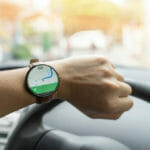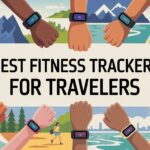Staying active is hard enough, right? Tracking steps and heart rate really shouldn’t add to the struggle.
That’s where fitness trackers come in. These little wrist gadgets count our every move, show how many calories we’ve burned, and nudge us to squeeze in those last 500 steps before bed.
There are a ton of fitness trackers out there, but not all of them get along with the apps we already use—especially Google Fit. Google Fit stands out because it pulls all our health and fitness info into one tidy spot. No endless scrolling or guesswork.
But here’s the catch—not every tracker syncs with Google Fit without a fight. If you want your stats to show up automatically, you’ve got to pick the right device.
Before buying, we need to think about what’s most important. Compatibility comes first (does it sync with Google Fit?), but battery life, comfort, and features matter too. Nobody wants an itchy wrist or a tracker that dies before lunch.
We tested fitness trackers that actually cooperate with Google Fit, hoping to find the ones that make it easy to keep all our health data in one place.
Best Fitness Trackers for Google Fit Integration
We all want to close those rings and maybe pretend we’re joggers, right? Our top picks for fitness trackers sync with Google Fit easily, so you can track steps, runs, and even those heroic fridge raids.
Let’s see which gadgets make getting active a little less intimidating.
Fitbit Inspire 3
If you want a fitness tracker that works with Google Fit, keeps you motivated, and doesn’t scream “cyborg,” this one’s a solid pick.
Pros
- Syncs smoothly with Google Fit
- Slim, lightweight design
- Battery lasts so long you might forget where the charger is
Cons
- Full features need a subscription (Fitbit Premium, sigh)
- GPS only works if your phone is nearby
- Small screen—your thumbs and eyes might grumble
Wearing the Inspire 3 felt like finally graduating from counting steps in our heads (and losing track after 27). All our Google Fit data slid in after setup, saving us a few extra taps and some mild frustration.
Syncing was simple once we figured it out—though it cost us a coffee and a quick YouTube search. We love that it tracks more than steps. Our sleep data actually proved we stayed up too late scrolling. The stress tracking spooked us when it told us to “Relax more,” but it tried to help with guided breathing.
Charging? Maybe once every 8–10 days. Our chargers barely got any action. On the downside, premium features hide behind a paywall, just like the best episodes of our favorite shows. If you want more detailed stats, you’ll get nudged to pay up.
The GPS uses your phone, so runners might wish it was more “independent.” The screen is small, so reading messages feels like squeezing into jeans from high school, but at least calls and notifications show up reliably.
The Inspire 3 covers most everyday health tracking needs and plays nice with Google Fit, all while staying light and comfy. Just don’t expect it to replace your phone or predict your future.
Fitbit Charge 6
If you want a fitness tracker that cozies up to Google Fit and makes you feel a bit like a secret agent, the Charge 6 is ready for your wrist.
Pros
- Built-in Google apps mean less juggling devices
- Battery outlasts our motivation (seriously)
- Comfortable enough to forget you’re wearing it
Cons
- The band starts off stiff, almost like medieval jewelry
- Color choices are a bit underwhelming
- No altimeter for stair-climbing fans
The Charge 6’s Google Fit integration is a real highlight. We got real-time heart rate on the gym treadmill and could control YouTube Music without touching our phone. Having Google Maps directions on our wrist felt futuristic—now if only it could help us find the remote.
Battery life? It actually lasted all week. We expected the usual nightly charge, but this tracker stuck around like that friend who never leaves the party. The band softens up after a few days, which is more than we can say for our muscles after a workout.
We liked the extra health tools for stress tracking and sleep scores—especially on those mornings when getting up feels like an Olympic event. Paying for snacks with Google Wallet during a run made us feel both fancy and slightly irresponsible.
If you care about counting stairs, you’ll miss the altimeter. Otherwise, the Charge 6 is a smart pick for Google Fit fans who want more than just the basics.
Fitbit Charge 6 Tracker
If you want a well-rounded fitness tracker that syncs with Google Fit and helps you outsmart your snooze button, this is a smart bet.
Pros
- Battery lasts so long, we sometimes forget where we left the charger
- Syncs easily with Google Fit and most phones
- Handles rain, sweat, and even our accidental pool dives
Cons
- Syncing requires a Fitbit-to-Google switch, which is a hassle
- Included bands can be uncomfortable (unless you like wrist rashes)
- SpO2 tracking is more of a mystery than a medical tool
The Fitbit Charge 6 helps us stick to our fitness goals and even calls us out for sneaky midnight snacks. With Google integration, we see step counts, sleep info, and get a gentle nudge to move just as we’re about to binge-watch.
The battery keeps going for days, so we don’t have to remember to charge it constantly. Water? Bring it on. We jumped in the pool, forgot it was on, and it just kept ticking.
The display is crisp, and message alerts plus Google Wallet on our wrist are handy—especially when we’re out of excuses at the gym. Switching the account to Google is less fun than leg day, and the band isn’t our favorite unless you love sweating under silicone. SpO2 data shows up, but don’t expect a deep dive.
As fitness trackers for Google Fit go, we’d keep this one on our wrist over most others.
BSLIZHEN Fitness Tracker C60
If you want a fitness tracker that works with Google Fit and doesn’t wreck your budget, this one’s a winner (or at least deserves a sweaty high five).
Pros
- Super bright AMOLED touchscreen, easy to read—even when you’re squinting after a workout
- Tracks heart rate, blood oxygen, and sleep 24/7 without begging for a charge every night
- Loads of watch face options, so you can look stylish while pretending you’re athletic
Cons
- Setup has more steps than we take on leg day
- The app needs downloading and some patience for syncing with Google Fit
- Strap style isn’t as fancy as pricier brands
With the BSLIZHEN C60, you don’t have to overthink tracking fitness goals. The screen is sharp, so even if you forget your glasses (just us?), you’ll still see your stats.
It’s lightweight, comfy, and not so big that it snags every time you zip up your jacket. After a week, we noticed the sleep and heart tracking actually mattered—not just numbers to ignore.
Notifications work well, so you won’t miss Aunt Linda’s latest meme. Syncing to Google Fit took a bit of setup, but once we figured it out (and resisted throwing our phone), it worked smoothly and shared all our steps, heartbeats, and workouts automatically.
For a no-nonsense tracker that covers the basics and then some, we’d give this a thumbs-up—if only we weren’t busy counting steps!
Fitbit Versa 4
If you want a fitness tracker that plays especially nice with Google Fit and outlasts your average attention span, the Versa 4 is a solid pick.
Pros
- Long battery life means less time charging, more time pretending to be athletic
- Google Fit integration is easy—your activity data ends up in the right place
- Lightweight and comfy—no wrist fatigue during binge-walking (or binge-watching)
Cons
- Some features hide behind a subscription, which is the grown-up version of “pay to unlock the next level”
- Notification syncing can lag if your phone’s having a mood
- Built-in apps are basic—no DJ party on your wrist yet
We strapped on the Fitbit Versa 4 for a week and it didn’t let us down, even when we skipped our run and hit our Step Goal thanks to a frantic cleaning session. Swapping between 40+ exercise modes was almost as exhausting as the workouts, but it kept things interesting.
Google Fit syncing is painless, which we really appreciate. Steps, heart rate, and general struggle are always ready in the app. Reading messages on our wrists was handy, even if we sometimes ignored them—sorry, group chat.
A few things could be better. Our favorite metric—sleep quality—hides behind a subscription. The built-in apps feel basic. Still, the battery refuses to quit, and the fit is comfy all day.
If your main goal is syncing with Google Fit without breaking the bank, Versa 4 gets our vote—quirks and all.
Wontrum Health Fitness Tracker
If you want a fitness tracker that connects to Google Fit about as easily as you forget your gym membership number (don’t we all?), this one’s probably your new go-to.
Pros
- Ultra HD screen looks sharp and responds quickly
- 128+ exercise modes—covers almost any sport, even the weird ones you only see on TV
- Battery lasts so long you’ll forget where you put the charger
Cons
- Syncing all your health info with Google Fit isn’t as smooth as it could be
- It’s a bit bulkier than some slimmer models
- No built-in GPS—you’ll need your phone for that
We strapped on the Wontrum Health Fitness Tracker and immediately noticed how bright that screen is. Tapping through the menus felt easy, and we even set a custom watch face with a vacation photo we probably shouldn’t have used.
No more squinting at numbers, even during squats or when we’re sneakily checking notifications at work.
With more than 128 exercise modes, this tracker feels prepared for anything—even competitive hopscotch, if that’s your thing. The health sensors tracked our heart rate and SpO2 without making us feel like lab rats.
Our sleep stats actually made sense, too. Looking back at a week of sleep cycles gave us a few new excuses for feeling grumpy.
We did run into a few annoyances. If you’re really into Google Fit, syncing everything feels more manual than magical. The watch also feels a bit chunky during cardio, especially if you have skinny wrists.
Still, the battery life made up for a lot. We barely had to think about charging it. If you can live with a few trade-offs, the Wontrum does pretty much everything—except the workout itself.
BrilliantHouse Fitness Tracker
If you want a budget-friendly fitness tracker that syncs with Google Fit and doesn’t feel like a brick on your wrist, this one deserves a second glance.
Pros
- Cheap enough to leave you money for snacks
- Tracks steps and heart rate, so your lazy days don’t go unnoticed
- Reminds you to move and drink water (it’s persistent, trust us)
Cons
- The display is small, so get ready to squint
- Build quality is, well, just okay—maybe don’t bump into walls
- Band doesn’t seem built for the long haul
For the price, the BrilliantHouse Fitness Tracker covers all our basics. It syncs with Google Fit quickly, so we can keep our steps, heart rate, and sleep mumbo jumbo in one spot.
The band is lightweight and fits almost anyone, which is handy since someone always loses the charging cable (it’s got a built-in USB, thankfully).
It kept up with our walks, runs, and questionable attempts at yoga. The step counter seemed pretty accurate, at least compared to our rough guesses.
Reminders to move or hydrate pop up often—sometimes annoyingly so, but maybe we need it. Don’t expect detailed tracking on the tiny, sometimes tricky screen.
You probably won’t wear this to a fancy dinner, but it survives the gym and family health lectures just fine. The build isn’t the toughest (we scratched one just walking past the couch), but if you want a cheap way to track your basics and sync to Google Fit, this could work… at least until the band gives out again.
FITVII Health & Fitness Tracker
If you’re wondering whether to buy this for Google Fit, the answer is a pretty solid “yes” if you want lots of features for less cash—just know there are some quirks.
Pros
- Connects easily to Google Fit and covers all the basics
- Lets you answer calls from your wrist—no more phone fumbles
- More sports modes than we have hobbies (over 120!)
Cons
- Plastic band could be softer—hairy arms, beware
- Icons and touch controls are small
- Build feels more “plastic” than “premium”
Setting up the FITVII Health & Fitness Tracker with Google Fit was actually easy. That’s not always the case with fitness tech.
It tracks steps, heart rate, blood oxygen, and sleep without making us dig through confusing menus. The Bluetooth calling feature saved us from dropping our phones more than once this week.
Swiping around the big screen is simple, though not perfect—the icons are tiny, and our thumbs sometimes got in the way (maybe it’s all the snacks). The “move” reminders are helpful, if a little annoying.
The FITVII offers enough sports modes to make us feel like we could go pro, even if our main sport is couch lounging.
Durability is okay, but the band feels basic. If you’re rough on your stuff or have sensitive skin, you might want to swap it out.
It’s water resistant, so we didn’t panic when we spilled coffee on it. Battery life is solid, and the speaker for calls and music is surprisingly clear.
If you want lots of features and easy Google Fit syncing, and don’t mind a plastic feel, this tracker is a smart pick.
Fitbit Inspire 3
If you want a straightforward, friendly fitness tracker that works with Google Fit, the Fitbit Inspire 3 is a strong option for your wrist.
Pros
- Light and comfortable—you’ll barely notice it
- Sleep tracking that actually helps
- Only needs charging about once a week
Cons
- Display is small if you’re used to bigger screens
- Needs your phone nearby for GPS
- Syncing notifications can be a little confusing
We got used to wearing the Inspire 3 all day and night faster than expected. The band is so light we sometimes checked to make sure it was still there (it always was).
During morning walks, tracking steps and heart rate felt effortless. The stats are clear, and we didn’t have to squint—unless someone sent a novel-length text.
Sleep tracking turned the Inspire 3 into our bedtime coach. It broke down our sleep into zones and, honestly, just confirmed we need to go to bed earlier.
The stress and heart rate features came in handy, especially on days with too much coffee or family visits.
Charging is simple, and we got almost ten days before needing to plug in. We wish it had built-in GPS, but the slim style and long battery life make it a reliable daily tracker.
If you’re tired of bulky trackers or want something you’ll forget you’re wearing, the Fitbit Inspire 3 is worth a try—even if your group chats still send you buzzing notifications.
Amazfit Band 7
If you want a straightforward fitness tracker that works with Google Fit and doesn’t need a daily charge, this band is a smart pick—even for smaller wrists.
Pros
- Battery lasts ages—no need to charge every day
- Tracks more sports than you’ll ever try
- Alexa integration adds a fun, futuristic touch
Cons
- Display is small if your eyesight isn’t great
- No built-in GPS—you’ll need your phone
- The clasp can be fiddly if you’re all thumbs
We took the Amazfit Band 7 for a spin and found that the battery outlasted our motivation to work out. Eighteen days without charging feels almost unreal, especially compared to trackers that barely last a weekend.
The AMOLED screen pops, though some of us had to squint at the smaller icons (maybe it’s just age catching up).
Heart rate and sleep monitoring stood out. We got detailed reports about when we were snoring, tossing, or just lying awake dreading Monday.
Syncing everything with Google Fit was easy, so our fitness stats followed us everywhere. Tracking over 120 sports is wild—even if we stick to the treadmill.
Wearing the band in the shower felt risky at first, but it handled water like a champ. Alexa integration gave us a few laughs, especially when it misunderstood “rain” for “train” during a run.
The Amazfit Band 7 gives you a lot without draining your wallet or phone battery. It’s not perfect, but it’s fun and handy for daily health tracking.
Buying Guide
Let’s be real—everyone’s after the smartest tracker, but who wants a user manual the size of a novel? Picking the right one for Google Fit? First thing’s first, check if it actually syncs up. If it doesn’t, what’s the point?
Key Features to Eye On:
- Battery life: No one enjoys plugging in every single night.
- Display: Stats should be right there, not a guessing game.
- Water resistance: Sweat happens. Showers happen. Sometimes, we even swim.
- Steps, heart rate, and sleep tracking: Gotta have the basics.
- Comfort: If it hurts, you’re not gonna wear it.
Here’s a table to keep things simple:
| Feature | Why It Matters |
|---|---|
| Battery Life | Less charging, more moving |
| Comfort | Nobody wants a wrist bruise |
| Water Resistance | Survives showers and splashes |
| Display | Easy to check on-the-go |
| Syncs with Google Fit | Must-have for our goals |
Check if the app’s actually easy to use. Who wants to dig around just to find their step count?
An easy setup saves time—and honestly, it’s more fun to show off your streak than to troubleshoot.
If it tracks calories or packs in extra sensors, cool. But, not every feature’s a must. Figure out what matters to you before you end up overthinking the whole thing.
- How to connect Bluetooth headphones to a Chromebook Without Summoning Tech Support - December 15, 2025
- Best Fitness Trackers for EMS Workers: Because Your Heart Rate Isn’t the Only Thing Racing - December 15, 2025
- Why do my Bluetooth headphones not skip tracks? Tech tantrums and other musical mysteries - December 14, 2025
















